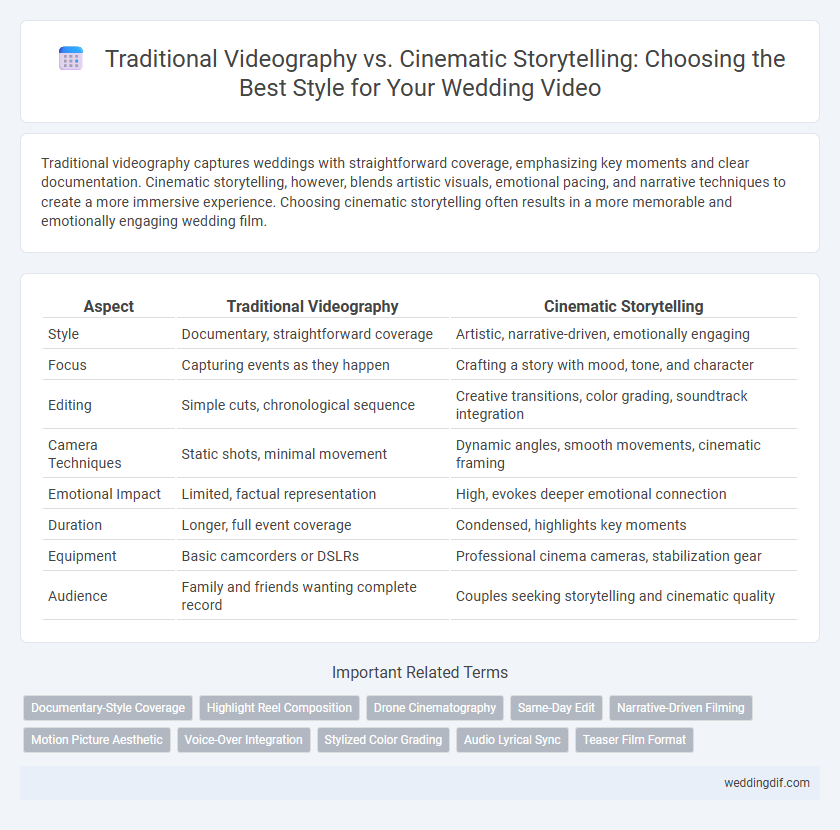Traditional videography captures weddings with straightforward coverage, emphasizing key moments and clear documentation. Cinematic storytelling, however, blends artistic visuals, emotional pacing, and narrative techniques to create a more immersive experience. Choosing cinematic storytelling often results in a more memorable and emotionally engaging wedding film.
Table of Comparison
| Aspect | Traditional Videography | Cinematic Storytelling |
|---|---|---|
| Style | Documentary, straightforward coverage | Artistic, narrative-driven, emotionally engaging |
| Focus | Capturing events as they happen | Crafting a story with mood, tone, and character |
| Editing | Simple cuts, chronological sequence | Creative transitions, color grading, soundtrack integration |
| Camera Techniques | Static shots, minimal movement | Dynamic angles, smooth movements, cinematic framing |
| Emotional Impact | Limited, factual representation | High, evokes deeper emotional connection |
| Duration | Longer, full event coverage | Condensed, highlights key moments |
| Equipment | Basic camcorders or DSLRs | Professional cinema cameras, stabilization gear |
| Audience | Family and friends wanting complete record | Couples seeking storytelling and cinematic quality |
Understanding Traditional Wedding Videography
Traditional wedding videography captures events in a straightforward, documentary style, emphasizing clear coverage of key moments like vows, speeches, and dances without artistic enhancements. It relies on standard camera angles and minimal editing to preserve the authenticity and sequence of the ceremony. This approach prioritizes reliability and comprehensive documentation over cinematic narrative techniques or visual artistry.
The Essence of Cinematic Storytelling in Weddings
Cinematic storytelling in weddings captures the emotional depth and unique narrative of the couple's journey, using techniques like dynamic camera angles, lighting, and sound design to create a film-like experience. Unlike traditional videography that focuses on recording events chronologically, cinematic storytelling emphasizes mood, pacing, and artistic composition to evoke genuine feelings and memorable moments. This approach transforms wedding films into timeless stories that resonate on a personal and emotional level, elevating the overall visual experience.
Key Differences Between Traditional and Cinematic Approaches
Traditional wedding videography emphasizes straightforward documentation with fixed shots and minimal editing, capturing events as they unfold. Cinematic storytelling involves dynamic camera movements, creative lighting, and narrative-driven editing to evoke emotions and highlight moments artistically. Key differences lie in the visual style, storytelling techniques, and post-production processes, with cinematic approaches prioritizing mood and atmosphere over mere event recording.
Visual Styles: Classic vs Cinematic Aesthetics
Traditional videography for weddings captures events with straightforward, clear visuals emphasizing documentation, often using static shots and standard angles to ensure all moments are recorded. Cinematic storytelling employs dynamic camera movements, creative angles, and color grading techniques to evoke emotion and craft a narrative, resulting in visually rich, film-like aesthetics. The contrast between classic clarity and artistic expressiveness defines the visual styles, shaping how wedding memories are preserved and experienced.
Editing Techniques: Linear vs Story-Driven
Traditional videography relies on linear editing techniques, arranging clips in chronological order to capture the wedding's events as they happened. Cinematic storytelling employs story-driven editing, weaving visuals and audio to evoke emotions and highlight key moments through non-linear sequences. This approach emphasizes mood, pacing, and narrative flow, creating a more immersive and memorable wedding film experience.
Impact on Wedding Memories
Traditional videography captures wedding events in a straightforward, chronological manner, ensuring every moment is documented with clarity. Cinematic storytelling enhances emotional impact by blending creative angles, lighting, and narrative techniques to craft a compelling visual experience. Couples often find cinematic styles preserve the essence and emotions of their wedding day more vividly, creating lasting memories with immersive storytelling.
Equipment Used: Basic vs Advanced Technology
Traditional videography for weddings relies on basic equipment such as handheld camcorders and standard lenses, delivering straightforward coverage with minimal post-production editing. Cinematic storytelling employs advanced technology including high-resolution mirrorless or cinema cameras, stabilizers like gimbals, drones for aerial shots, and sophisticated lenses that enhance depth and focus, creating visually immersive narratives. The integration of professional lighting and color grading tools further distinguishes cinematic wedding films by elevating the mood and emotional impact.
Budget Considerations for Each Style
Traditional videography for weddings typically involves straightforward coverage with minimal editing, making it more budget-friendly due to lower production time and fewer post-production requirements. Cinematic storytelling demands higher investment in equipment, creative direction, and extensive editing processes to craft a visually compelling narrative. Couples should balance their budget against desired video quality and storytelling depth when choosing between these styles.
Choosing the Right Videography Style for Your Wedding
Selecting the right videography style for your wedding hinges on your desired emotional tone and storytelling preference. Traditional videography captures key moments with straightforward coverage, focusing on clarity and completeness, while cinematic storytelling employs creative camera work, lighting, and editing to craft a narrative-driven film that highlights emotions and atmosphere. Couples seeking a timeless, documentary-style record may prefer traditional methods, whereas those wanting an artistic, immersive experience often opt for cinematic storytelling.
Final Thoughts: Which Style Suits Modern Couples?
Traditional videography offers a straightforward, event-focused approach capturing every key moment with clarity and completeness. Cinematic storytelling, favored by modern couples, emphasizes emotional depth and artistic composition, weaving a narrative that mirrors the wedding day's unique atmosphere. Choosing between these styles depends on personal preference for either comprehensive documentation or a visually immersive, storytelling experience.
Traditional Videography vs Cinematic Storytelling for weddings. Infographic

 weddingdif.com
weddingdif.com